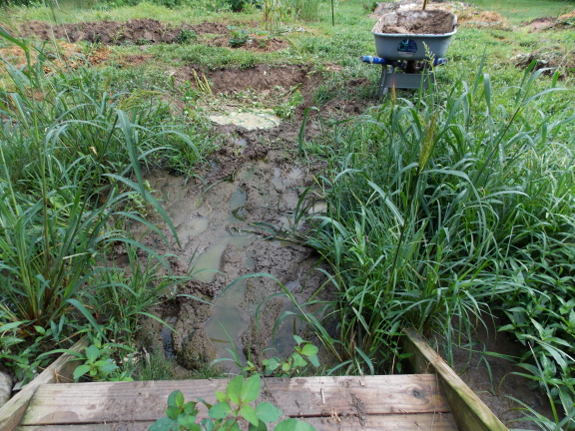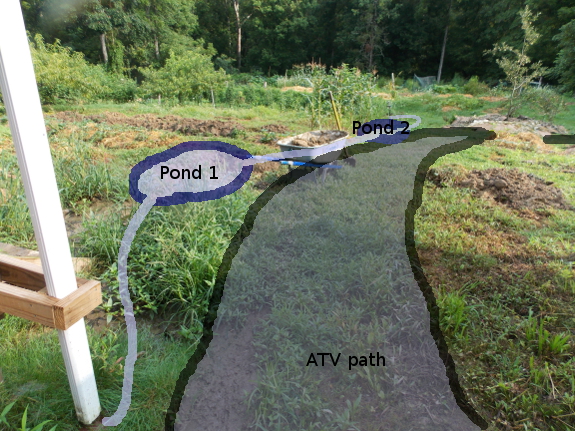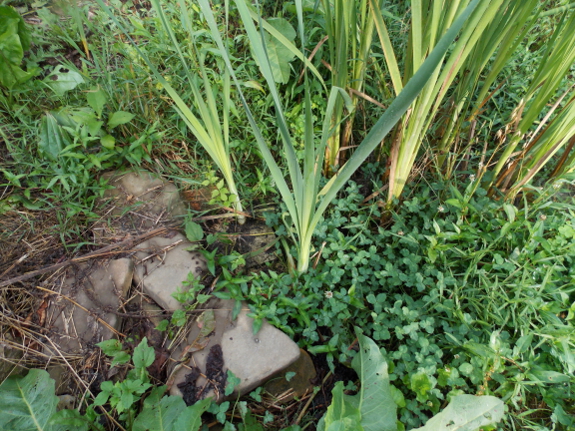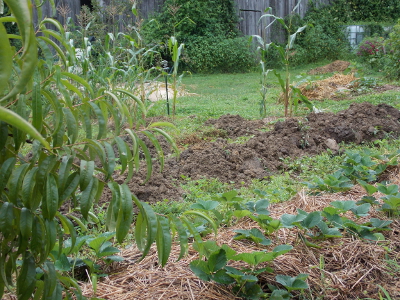
Planning the gutter-overflow pond

While the honest
truth is that I just like digging holes and playing in the mud, I
do have a plan surrounding our newest
pond experiment.
The photo above shows the swamp you have to wade through when
leaving the north side of the East Wing porch. The
groundwater is close to the surface there and all of the rain
pouring off the roof results in a waterlogged mess. My
general goal in our core homestead is to never have to slog
through the mud, so I need to channel that water somewhere out of
the way.
(Gerry asked why we
don't just install a rain barrel under that gutter. While
his idea has merit for the dry season, we'd still have to deal
with overflow from the rain barrel when we don't have a use for
the water. So it makes sense to figure out where that
overflow will go now.)

So what's my plan for
the excess water? Mark recently decided to make an ATV loop
around the forest garden so it would be easier to drop off manure
and straw by the barn, and I want to leave that driveway area open
(and hopefully dry). To that end, I plan to attach the
gutter downspout to a lightly buried pipe heading to our current
pond excavation, then I suspect I'll have to bury an overflow from
that pond leading to another little pond halfway down the
hill. From there, I'm prepared to channel extra overflow
into the gully.
The jury's still out
on whether my ponds will hold water. (More on my experiments
with sealing in a later post.) And I'm curious to see
whether they'll make the surrounding soil more or less
soggy. But I'm planning the pond locations carefully to keep
them away from major thoroughfares, so at worst they'll serve
their primary purpose of getting the mud away from the steps.

Speaking of keeping
water away from steps, our greywater
wetland is serving that purpose admirably. Mark called
it a stellar success, and while there are a few things I want to
change in this second incarnation, I'm quite happy with the
complete absence of muck and smells. (The swamp gas wafting
up into our kitchen sink in June disappeared with no work on our
part a couple of weeks after appearing. My best guess is
that some kind of good microbial community came in to overrun the
bad one, but I don't really know what happened for sure.)
 What don't I like about
version 1.0? I mounded up the excavated soil to make big
walls around the wetland, which makes it tough to mow (Mark uses a
weedeater) and makes the whole thing stick out of the landscape a
bit. For version 2.0, I'm instead using the dug-out earth to
raise up garden beds in the waterlogged back garden.
What don't I like about
version 1.0? I mounded up the excavated soil to make big
walls around the wetland, which makes it tough to mow (Mark uses a
weedeater) and makes the whole thing stick out of the landscape a
bit. For version 2.0, I'm instead using the dug-out earth to
raise up garden beds in the waterlogged back garden.
And while I didn't
want standing water in the greywater wetland, I'm hoping to make
version 2.0 into a pond instead of a marsh. The cleaner
water coming off the roof won't be problematic in the form of open
water, and my lotus has sent out a runner that needs a new
home. So now it's time to think of step two --- sealing my
clay pit.
Want more in-depth information? Browse through our books.
Or explore more posts by date or by subject.
About us: Anna Hess and Mark Hamilton spent over a decade living self-sufficiently in the mountains of Virginia before moving north to start over from scratch in the foothills of Ohio. They've experimented with permaculture, no-till gardening, trailersteading, home-based microbusinesses and much more, writing about their adventures in both blogs and books.
Want to be notified when new comments are posted on this page? Click on the RSS button after you add a comment to subscribe to the comment feed, or simply check the box beside "email replies to me" while writing your comment.

I would consider using perforated 4 inch Sewer and Drain Pipe for the run.It is fairly cheap. http://www.homedepot.com/p/Advanced-Drainage-Systems-4-in-x-10-ft-Corex-Drain-Pipe-Perforated-4040010/100211970#.UfajItK-qFY
Look at Septic tank leeching field construction for proper installation details. It would help to drain your swampy area from underneath.
I agree with you on the rain barrels. I’ve found that rain barrels are useful in collecting extra water, but not necessarily helpful in resolving drainage issues. I have 4 around my house, one at each gutter downspout. I love them because we don’t have an outdoor faucet close to 2 of the barrels. Now I don’t have to drag a hose or carry water too far. Each has a faucet near the bottom and an overflow spout near the top. I have them elevated so I can get a bucket under the faucet. I have a hose attached to the overflow so I can route it away from the house and they’re on a bed of gravel to help keep the area around them from washing out. I also have mesh enclosing the open area at the top where the gutter flows into the barrel to keep out debris and mosquitoes. My husband did an excellent job making these very cheaply and I’m planning to add 2 more to the house and several to our outbuildings. We don’t usually have the amount of rain we’ve had this year so extra water is in high demand.
The problem with rain barrels is heavy rains will overwhelmed them so you must plan carefully to manage the overflow. There’s a lot of water coming off a roof! I had just set up a barrel on Friday and we had a little over 2 inches of rain. That empty 55 gallon barrel filled up in minutes. The overflow spout/hose couldn’t handle all of the water flowing into the barrel so it had to come out of the top of the barrel and boy did it! It’s not a big deal with my barrels since I knew this would happen and have situated each to allow the extra water drain away from the house, but if you’re looking to resolve drainage issues it would take are REALLY, REALLY BIG barrel. I’m watching your greywater ponds with great interest. I’m thinking of routing some of our greywater to create a marsh area sometime in the future. You mentioned something about running a pipe to your pond from your gutter. I’m not sure what type of pipe you’re planning on using, but wanted to tell you my tale of horror. Years ago my husband connected 2 of our downspouts into one of those black corrugated pipes that have holes and lightly buried it. I’ve seen these with a mesh covering to keep out roots, but this one did not have that. Everything drained well for several years without problem. Prior to installing the rain barrels I noticed that our gutters were overflowing during heavy rain even though they were clean. The problem was only 2 of our 4 downspouts worked. The other 2 were full of debris almost halfway to the downspout because the pipes he used were full of roots and dirt so they no longer drained. Gutters are great when they work, but when they don’t drain properly they can cause lots of damage.
Tom and tee --- I've got yet another post coming up later in the week about piping into the pond. The short version is that we opted for the corrugated drainpipe without perforations because I wanted to channel all of the water into the pond rather than into the surrounding soil. I suspect tee's experience with perforated pipes is why the internet tells you to layer them between several inches of gravel. However, my next project might involve using a perforated pipe to drain a swampy area that's not fed by the roof.
Anonymous --- I've never had problems with mosquitoes in my ponds once I got the biology running. Fish and insects (and maybe frogs) do a good job eating them up and I've never had to buy specific mosquitoe-eating fish either.